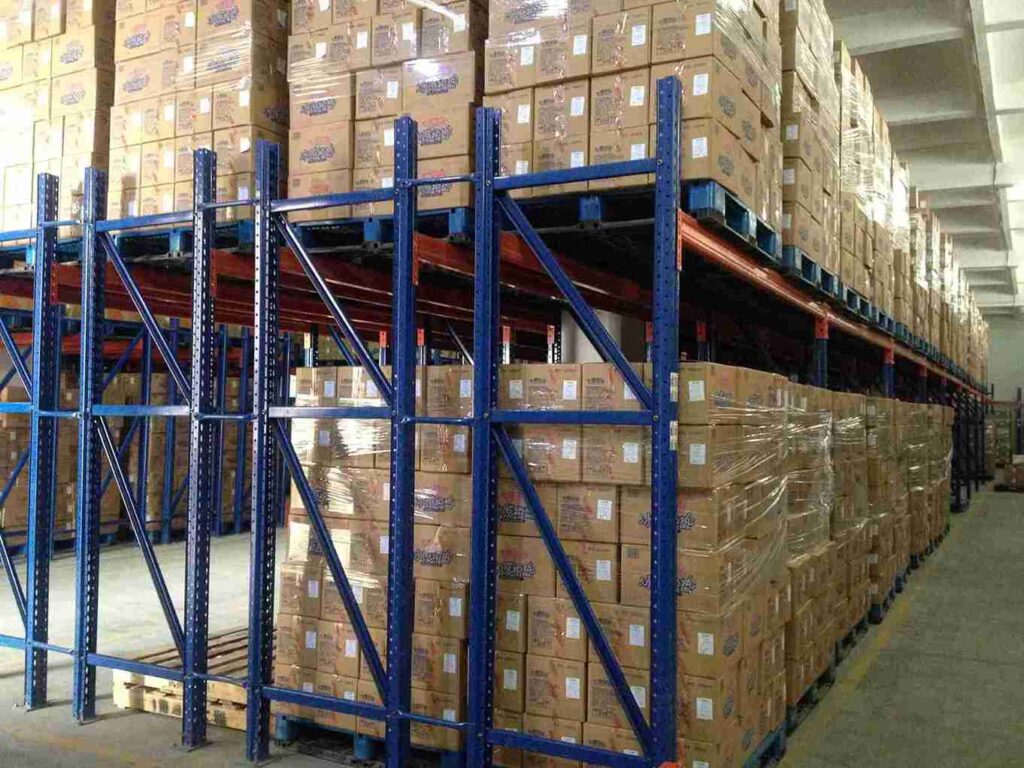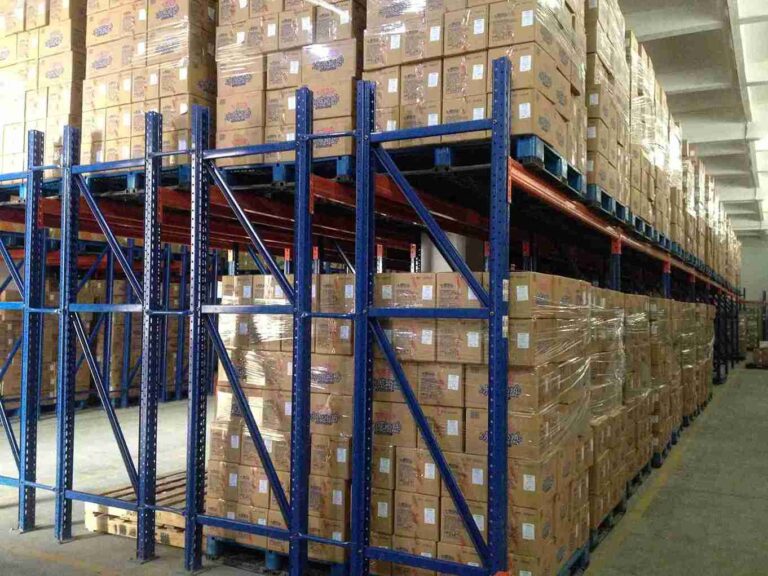📐"前 50 个企业查询可获得定制 3D 仓库设计" 计划

Introduction: The Ultimate Guide to Double Deep Racking Systems
In today’s competitive warehousing and logistics industry, maximizing warehouse space while reducing operational costs is a top priority. Double deep racking systems offer a powerful solution, allowing businesses to increase storage capacity by up to 85% and cut warehouse costs by 40% or more.
Unlike traditional selective pallet racking, double deep racking stores pallets two-deep, significantly optimizing warehouse space. This system is ideal for high-volume operations with homogeneous SKUs, reducing aisle space and improving efficiency.
In this comprehensive guide, we’ll explore:
- How double deep racking systems work
- Key benefits and cost savings
- Best applications and industries
- Comparison with other racking systems
- Safety considerations and installation tips
- How to get a free consultation for your warehouse
By the end, you’ll understand why double deep racking is a game-changer for modern warehouses looking to maximize warehouse space.

1. What Is a Double Deep Racking System?
A double deep racking system is a high-density storage solution where pallets are stored two-deep instead of single-deep (as in selective racking). This design reduces aisle space, allowing for more storage capacity within the same warehouse space.
How It Works
- Two pallets deep per bay (instead of one)
- Requires specialized forklifts (reach trucks with extended reach)
- Ideal for high-volume, low-SKU-variation inventory
Key Components
- Upright frames (heavy-duty steel columns)
- Beams (support pallets two-deep)
- Wire decking or pallet supports (for stability)
- Guide rails (prevent forklift damage)
This system is not random-access like selective racking, meaning the second pallet must be accessed after the first.
2. Benefits of Double Deep Racking Systems
1. Maximizes Warehouse Space Efficiency
By storing pallets two-deep, businesses can increase storage capacity by 40-85% compared to single-deep racking. Fewer aisles mean more usable warehouse space.
2. Reduces Operational Costs
- Lower real estate costs (more storage in the same warehouse space)
- Reduced energy expenses (smaller warehouse footprint = lower HVAC/lighting costs)
- Fewer forklifts needed (due to optimized layout)
3. Improves Inventory Management
Best for FIFO (First-In, First-Out) or LIFO (Last-In, First-Out) systems, especially in industries like food & beverage, retail, and manufacturing.
4. Enhances Safety & Durability
- Heavy-duty steel construction (supports high loads)
- Guide rails prevent accidents (reduces forklift collisions)
5. Scalable & Flexible
Can be integrated with other systems (like push-back racking or drive-in racking) for hybrid solutions.
3. Double Deep vs. Other Storage Systems
Double Deep vs. Selective Racking
| Feature | Double Deep Racking | Selective Racking |
|---|---|---|
| Storage Depth | 2 pallets deep | 1 pallet deep |
| Aisle Space | Fewer aisles | More aisles |
| Accessibility | Limited (LIFO/FIFO) | Instant (any pallet) |
| Best For | High-volume, similar SKUs | High-SKU variety |
Double Deep vs. Drive-In Racking
- Drive-in racking allows deeper storage (6+ pallets deep) but reduces accessibility.
- Double deep offers a balance between density and accessibility.
Double Deep vs. Push-Back Racking
- Push-back racking stores 3-5 pallets deep but requires more maintenance.
- Double deep is simpler and more cost-effective for moderate density needs.
4. Industries That Benefit Most from Double Deep Racking
1. Food & Beverage
- High-volume, perishable goods (FIFO-friendly)
- Examples: Beverage distributors, frozen food warehouses
2. Retail & E-Commerce
- Fast-moving consumer goods (FMCG)
- Bulk storage for seasonal items
3. Manufacturing & Automotive
- Raw material storage
- Just-in-time (JIT) inventory systems
4. Pharmaceuticals & Healthcare
- Batch storage for medicines
- Regulated inventory tracking
5. Safety & Installation Best Practices
Key Safety Features
- Forklift training (for extended-reach trucks)
- Load capacity labels (prevents overloading)
- Regular inspections (checks for beam damage)
Installation Tips
- Professional assessment (ensure floor load capacity)
- Proper spacing (avoid over-tight configurations)
- Seismic considerations (in earthquake-prone areas)
6. How to Implement Double Deep Racking in Your Warehouse
Step 1: Evaluate Your Inventory
- SKU velocity (fast vs. slow-moving items)
- Pallet dimensions & weight
Step 2: Choose the Right Forklifts
- Reach trucks with extended forks
- Narrow-aisle forklifts (for tighter spaces)
Step 3: Optimize Layout
- Work with racking experts for space planning
- Simulate workflows before finalizing design
Step 4: Get a Free Consultation
Many racking suppliers offer free warehouse assessments to determine if double deep racking is right for you.
7. Cost Analysis: Is Double Deep Racking Worth It?
Initial Investment
- 150 per pallet position (varies by material & height)
- Forklift upgrades (if needed)
ROI & Savings
- 40%+ cost reduction in long-term storage expenses
- Higher ROI than selective racking for high-density needs
8. Future Trends in High-Density Racking
- Automation integration (AGVs, robotic forklifts)
- Hybrid systems (combining double deep with AS/RS)
- AI-powered warehouse optimization
9. Conclusion: Why Double Deep Racking is a Smart Investment
Double deep racking systems are a proven, cost-effective solution for warehouses needing higher storage density. By reducing aisle space and increasing capacity, businesses can cut costs by 40% or more while maintaining efficient operations.
If you’re considering upgrading your warehouse storage, a free consultation with a racking expert can help determine if double deep racking is the right fit.
10. Frequently Asked Questions (FAQs)
1. Can double deep racking work with mixed SKUs?
Yes, but it’s best for similar SKUs due to limited accessibility.
2. What forklifts are needed for double deep racking?
Reach trucks with extended forks are required.
3. How much weight can double deep racking hold?
Typically 5,000–20,000 lbs per level, depending on design.
4. Is double deep racking suitable for cold storage?
Yes, it’s ideal for cold warehouses due to space efficiency.
5. How long does installation take?
Usually 1–3 weeks, depending on warehouse size.
By following this guide, you’ll have everything you need to decide if double deep racking is the best solution for your warehouse. Contact us today for a free consultation!




